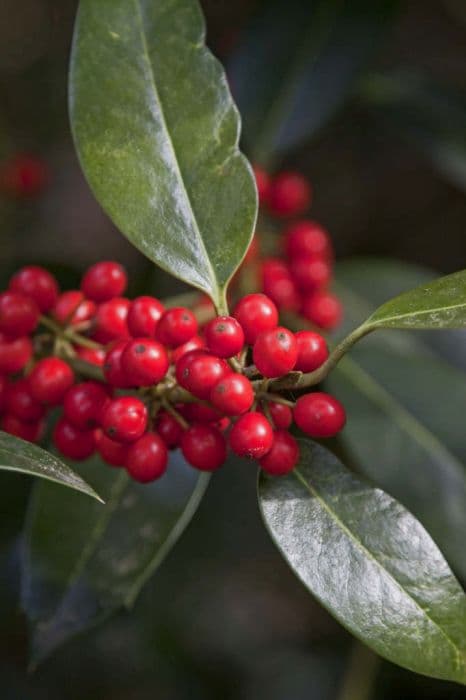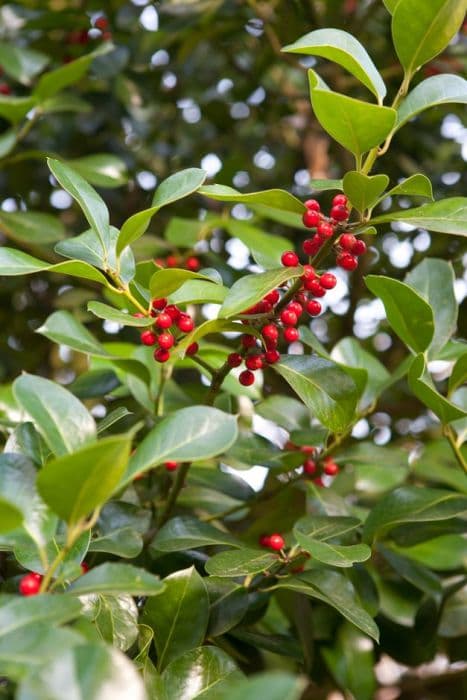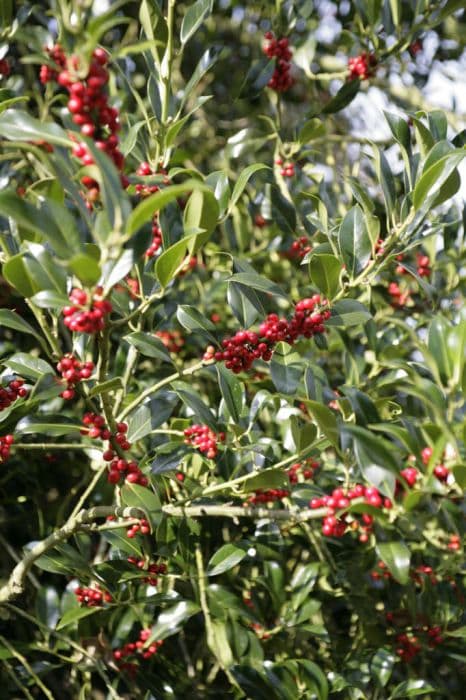Perry's weeping silver Ilex aquifolium 'Argentea Marginata Pendula' (f/v)

ABOUT
'Argentea Marginata Pendula' is a small tree, up to 4m high, with drooping branches and which will eventually form a small dome, pyramid or mushroom shape. Spiny leaves, purple when young, are dark green with a broad creamy edge and up to 8cm long. White flowers in spring or early summer are followed by bright red berries in autumn and winter
About this plant
 Names
NamesFamily
Aquifoliaceae
Synonyms
Silver Margin Pendula Holly, Weeping Silver Holly, Variegated Weeping Holly
Common names
Ilex aquifolium 'Argentea Marginata Pendula'
 Characteristics
CharacteristicsLife cycle
Perennials
Foliage type
Evergreen
Color of leaves
Variegated
Flower color
White
Height
6-10 feet (1.8-3 meters)
Spread
4-8 feet (1.2-2.4 meters)
Plant type
Shrub
Hardiness zones
5
Native area
Europe
Benefits
 General Benefits
General Benefits- Ornamental Appeal: The variegated leaves with silver edges and weeping habit provide an attractive addition to gardens or landscapes.
- Wildlife Habitat: Provides food and shelter for birds, offering berries in winter when food is scarce.
- Year-Round Interest: Evergreen nature ensures that the garden has visual interest even in the coldest months.
- Drought Resistance: Once established, it has a good tolerance for drought, making it suitable for drier climates or water-wise gardens.
- Low Maintenance: Requires minimal pruning and can thrive without needing excessive care or fertilization.
- Hedge and Border Plant: Ideal for creating structured hedges or borders due to its dense foliage and ability to be pruned into shape.
- Tolerance of Shade: Can grow in partial shade, making it versatile for different garden aspects.
- Privacy Screen: Dense and evergreen features make it an effective plant for privacy screening.
 Medical Properties
Medical PropertiesThis plant is not used for medical purposes.
 Air-purifying Qualities
Air-purifying QualitiesThis plant is not specifically known for air purifying qualities.
 Other Uses
Other Uses- Photography and Artistic Inspiration: Due to its striking variegated leaves and weeping form, the European Holly is often used as a subject for photographers and artists looking to capture its unique beauty.
- Privacy Screening: With its dense foliage, the European Holly can be grown as a pendulous screen, providing privacy while adding an elegant touch to the garden landscape.
- Bonsai: The pendulous variant of European Holly can be trained into a bonsai, creating an interesting specimen with its weeping branches and variegated leaves.
- Culinary Garnish: Although the berries are not edible, the variegated leaves can be used as a decorative garnish for festive dishes during the holiday season.
- Winter Garden Focal Point: Its evergreen nature and variegated foliage make the European Holly an ideal choice as a focal point in winter gardens when other plants have lost their leaves.
- Craft Material: European Holly branches can be used in making wreaths, garlands, and other festive decorations, especially during Christmas, due to their iconic look.
- Tattoo Design: For those wanting plant-themed body art, the European Holly's unique form and leaf patterns can serve as inspiration for tattoo designs.
- Religious and Cultural Symbolism: In some cultures, the European Holly is seen as a symbol of protection and is planted near homes with the belief that it wards off evil spirits.
- Education and Research: Horticulture students and plant researchers may use the European Holly 'Argentea Marginata Pendula' to study variegation patterns and pendulous plant growth habits.
- Theme Gardens: This variety of European Holly can be included in silver-themed gardens due to its silver-edged leaves, helping to create a monochromatic or moonlight garden effect.
Interesting Facts
 Feng Shui
Feng ShuiThe Silver Variegated Weeping Holly is not used in Feng Shui practice.
 Zodiac Sign Compitability
Zodiac Sign CompitabilityThe Silver Variegated Weeping Holly is not used in astrology practice.
 Plant Symbolism
Plant Symbolism- Protection: Ilex aquifolium, commonly known as Holly, has been traditionally associated with protection due to its spiky leaves. It was believed to safeguard against negative energies and was often used around homes for this purpose.
- Good Fortune: The Holly tree's evergreen nature symbolizes a wish for good fortune and endurance, as it remains vibrant throughout the harsh winter months.
- Fertility: With its robust growth and berry production, Holly is often viewed as a symbol of fertility and life continuation.
- Festivity: Holly is synonymous with Christmas in many cultures, representing joy, festivity, and the spirit of the holiday season.
- Rebirth: As an evergreen, Holly symbolizes rebirth and the idea of life persisting through the cold of winter into the renewal of spring.
 Water
WaterThe Silver Margin Holly, as Ilex aquifolium 'Argentea Marginata Pendula' is commonly known, should be watered deeply to ensure the root system is thoroughly moistened, achieving this by applying water slowly at the plant's base. It's important to avoid frequent shallow watering, instead aiming for about 1 to 2 gallons for smaller plants and up to 4 gallons for larger plants every week during the growing season, less in winter. Adjust the frequency based on weather conditions, watering more frequently during dry spells and less during periods of rain. Ensure well-draining soil to prevent waterlogging, which can cause root rot. Overwatering can be just as harmful as underwatering, so always check soil moisture before adding water.
 Light
LightSilver Margin Holly thrives in partial to full sunlight and can do well in varied lighting conditions. It's best to provide a spot where the plant can receive at least 4 hours of direct sunlight daily, with some protection from the harsh afternoon sun. Dappled sunlight or a place with morning sun and afternoon shade would be ideal to protect the variegated leaves from scorching.
 Temperature
TemperatureSilver Margin Holly is hardy and can withstand a range of temperatures, but it typically prefers cooler climates. It can survive in temperatures as low as -10°F and as high as 100°F, yet the ideal temperature range is between 30°F and 70°F. Protecting it from extreme cold winds and providing some shelter when temperatures dip below freezing can help maintain the health of the plant.
 Pruning
PruningPruning Silver Margin Holly is vital for maintaining its shape and promoting vigorous growth. It's best pruned in late winter or early spring before new growth begins, though trimming may be done in summer to shape or remove any damaged or diseased branches. Prune sparingly, as heavy pruning can diminish berry production, and always use clean, sharp tools to ensure clean cuts.
 Cleaning
CleaningAs needed
 Soil
SoilSilver Margin Weeping Holly (Ilex aquifolium 'Argentea Marginata Pendula') thrives in a soil mix that is rich in organic matter, well-draining, and slightly acidic to neutral. An ideal soil mix can be created using two parts garden loam, one part well-decomposed compost, and one part perlite or coarse sand to improve drainage. The soil pH should be between 5.5 and 7.0 for optimal growth.
 Repotting
RepottingSilver Margin Weeping Holly should be repotted infrequently, only when it has outgrown its current pot or the soil has become compacted. This is typically every 2 to 3 years. It's important to use a container only slightly larger than the previous one to prevent root rot.
 Humidity & Misting
Humidity & MistingSilver Margin Weeping Holly prefers moderate humidity levels but is adaptable to the average humidity found in most homes. It is important to ensure that the plant is not placed in an excessively dry environment as it can lead to stress and leaf drop.
 Suitable locations
Suitable locationsIndoor
Ensure bright light and keep soil moderately moist.
Outdoor
Plant in part-shade, shelter from harsh winds.
Hardiness zone
5-9 USDA
 Life cycle
Life cycleIlex aquifolium 'Argentea Marginata Pendula', commonly known as the Variegated Silver Holly, begins its life cycle when the seeds, often spread by birds who eat the berries, germinate and sprout in the spring after experiencing a period of winter dormancy to break seed dormancy. The seedling stage follows, where the young plant establishes itself and begins to develop its characteristic spiny leaves. During the vegetative stage, the holly grows and matures, slowly developing its arching pendulous branches and variegated leaves edged with creamy-white margins. As it enters the reproductive stage, which can take several years, the Ilex aquifolium 'Argentea Marginata Pendula' produces small white flowers that are followed by red berries if pollinated by a nearby male holly plant. After reaching full maturity, the holly can live for many decades, during which it goes through annual cycles of growth and dormancy, maintaining its evergreen foliage throughout the seasons. The holly eventually enters a senescence phase toward the end of its life cycle, where growth slows and the plant may become more susceptible to environmental stressors and diseases before it dies.
 Propogation
PropogationPropogation time
Early Spring
Ilex aquifolium 'Argentea Marginata Pendula', commonly known as Silver-margined Weeping English Holly, is typically propagated in late winter to early spring. The most popular method of propagation for this variety is through semi-hardwood cuttings. A gardener would take cuttings of about 4 to 6 inches (10 to 15 centimeters) long from the current year's growth. The lower leaves are removed, and the cut end is dipped in a rooting hormone to facilitate root development. The prepared cutting is then inserted into a pot filled with a mixture of peat and perlite to provide good drainage and aeration. The pot must be kept in a warm, humid environment, out of direct sunlight, to encourage rooting. Rooting typically takes place within 6 to 8 weeks, after which the new plant can be gradually acclimatized to outside conditions and eventually planted out in its permanent location.









